Exploring the Latest Trends in Music Artist Representation
Understanding the Evolution of Artist Representation
In recent years, the music industry has witnessed a significant transformation in how artists are represented. With the advent of digital platforms and the rise of social media, traditional methods of artist management are evolving rapidly. Today, representation is not just about negotiating contracts or organizing tours; it's about building a comprehensive brand that resonates with a global audience.
Music artists now have more control over their careers than ever before. The democratization of music production and distribution means that artists can bypass traditional gatekeepers and reach their fans directly. This shift has led to a new era where representation is more dynamic and multifaceted.

The Role of Technology in Modern Representation
Technology plays a crucial role in modern artist representation. From data analytics to virtual reality performances, technology is reshaping how artists connect with their audience. Advanced analytics tools allow representatives to gain insights into fan demographics, preferences, and engagement patterns. This data is invaluable in crafting personalized marketing strategies that resonate with target audiences.
Moreover, social media platforms like Instagram, TikTok, and YouTube have become essential tools for artists to build their brand and expand their reach. These platforms offer direct interaction with fans, enabling artists to cultivate loyal communities and promote their music organically.
Embracing Digital Distribution Channels
Digital distribution channels have revolutionized the music industry by providing artists with unprecedented access to global audiences. Services like Spotify, Apple Music, and Bandcamp make it easier for artists to distribute their music without relying on traditional record labels. This shift empowers artists to maintain greater control over their work and financial outcomes.

Collaborative Representation Models
The trend towards collaborative representation models is gaining traction, where artists work with a team of specialists rather than a single manager. These teams can include brand strategists, social media managers, digital marketers, and publicists who work collectively to enhance the artist's brand and visibility.
This team-based approach allows for more specialized expertise in various areas, ensuring that the artist's career is managed holistically. By leveraging the strengths of each team member, artists can effectively navigate the complex landscape of today's music industry.
Focus on Brand Development
Brand development has become a central focus in artist representation. Beyond their music, artists are encouraged to develop a unique personal brand that resonates with their target audience. This involves crafting a compelling narrative, maintaining a consistent visual identity, and engaging authentically with fans.

Navigating Legal and Financial Aspects
The legal and financial aspects of artist representation remain critical, even in this evolving landscape. Representatives continue to play an essential role in negotiating contracts, securing rights, and managing royalties. As new revenue streams emerge, such as NFTs and virtual concerts, representatives must stay informed about regulatory changes and financial opportunities.
Having a knowledgeable legal and financial team ensures that artists can focus on their creative pursuits while safeguarding their interests. This balance is vital for sustaining long-term success in the music industry.
- Leveraging Data Analytics
- Embracing Digital Platforms
- Building Collaborative Teams
- Focusing on Brand Development
- Navigating Legal Complexities
In conclusion, the latest trends in music artist representation highlight a more integrated and technologically driven approach to managing careers. As the industry continues to evolve, representatives must adapt by embracing new tools and strategies that reflect the changing dynamics of the music world.